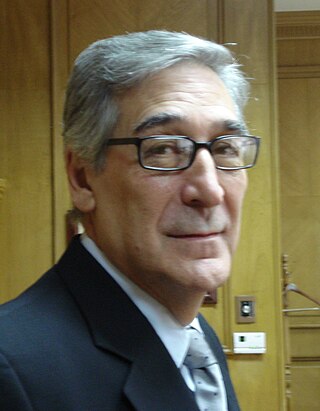
Bronco is a Mexican grupero band originating from Apodaca, Nuevo León. Their modern take on regional Mexican music in the 1980s and 1990s helped earn them international recognition with original band members José Guadalupe "Lupe" Esparza, Ramiro Delgado, Javier Villareal, and José Luis "Choche" Villareal creating music that would go on to top record charts. The band is well known for their use of modern instruments, particularly the synthesizer and musical keyboards, as part of the incorporation of pop-style music. As with many grupera bands, members wore matching jumpsuits.

Grupo Televisa, S.A.B., simply known as Televisa, is a Mexican telecommunications and broadcasting company. A major Latin American mass media corporation, it often presents itself as the largest producer of Spanish-language content.

San Pedro Garza García is a city-municipality in the Mexican state of Nuevo León and part of the Monterrey Metropolitan area. It is a contemporary commercial suburb of the larger metropolitan city of Monterrey between Puente de la Unidad and the Alfa Planetarium, including areas surrounding Calzada del Valle/Calzada San Pedro. In 2018 it was evaluated as having the best quality of life in Mexico. It has luxury shopping malls, large green areas, as well as important colleges and hospitals. Cerro de Chipinque and Chipinque Ecological Park are notable aspects of the city. The city hosts the head offices of companies like ALFA, Cemex, Gamesa, Vitro, Pyosa, Softtek and Cydsa.

Everardo Elizondo Almaguer is a Mexican economist who has worked for private, public, and academic institutions. By senatorial appointment, he served as deputy governor of the Bank of Mexico —the country's central bank— from 1998 to 2008.
Reforma is a Mexican newspaper based in Mexico City. It has 276,700 readers in Mexico City. The paper shares content with other papers in its parent newsgroup Grupo Reforma. Reforma is named after the Mexico City avenue of the same name, Paseo de la Reforma, which is in turn named after "La Reforma", a series of liberal reforms undertaken by the country in the mid-19th century.
Francisco "Paco" Calderón is a Mexican political cartoonist. He currently draws for the newspapers that belong to the Grupo Reforma.
El Sol is a Spanish phrase meaning "the sun". It may refer to:
Grupo Reforma is the largest printed media company in Mexico and Latin America. It publishes ten daily newspapers in five cities, including the leading newspapers in Mexico's three largest cities: Reforma in Mexico City, El Norte in Monterrey and Mural in Guadalajara. It also publishes the daily Metro in Mexico City, Monterrey, Guadalajara, Puebla and Toluca, and the afternoon tabloid El Sol in Monterrey. The average daily circulation of all these papers is 1.4 million copies.
Jorge Lankenau Rocha was a Mexican banker and businessman born in Monterrey, Nuevo León. He was founder and president of Grupo Financiero Abaco, one of the most important financial groups in Mexico in the 1990's.

María del Carmen Aristegui Flores is a Mexican journalist and news anchor. She is widely regarded as one of Mexico's leading journalists and opinion leaders, and is best known for her critical investigations of the Mexican government. She is the anchor of the news program Aristegui on CNN en Español, and writes regularly for the opinion section of the periodical Reforma. In March 2015, she was illegally fired from MVS Radio 102.5 FM in Mexico City following a report on the conflicts of interest by then Mexican President Enrique Peña Nieto with a state contractor. The contractor had allegedly built a millionaire residence for the president and his family. She manages her own news website and hosts an online morning newscast, which is also broadcast on Grupo Radio Centro's XERC-FM.

The Inter American Press Association is a press advocacy group representing major media organizations in North America, South America and the Caribbean. It is made up of more than 1,300 print publications throughout the Western Hemisphere and is based in Miami, Florida. Every year it issues its IAPA/SIP Excellence in Journalism Awards in the fields of cartoon, online news coverage, news coverage, coverage on mobile phones, features, human rights and community service, photography, infographics, opinion, data journalism, in-depth journalism and press freedom.
Enrique Canales (1936–2007), born in Monterrey, Nuevo Leon, Mexico, was a technologist, editor, political analyst, painter, and sculptor.

Manuel Sánchez is a Mexican economist with a wide-ranging professional career that includes positions in academics, banking, and central banking. He was nominated by President Felipe Calderón Hinojosa on April 23, 2009, as Deputy Governor and member of the Board of Governors at Banco de México, Mexico's central bank, for a term that ended on December 31, 2016. His appointment was ratified by the Standing Commission of the Mexican Congress on May 27, 2009.
El Norte is a daily newspaper printed and distributed in Monterrey, Nuevo León, Mexico.

"Amiga Mía" is a song by Spanish singer Alejandro Sanz from his fifth studio album, Más (1997). WEA Latina released it as the album's fourth single in the same year. The song was written by Sanz and produced by Miguel Angel Arenas and Emanuele Ruffinengo. The rock ballad carries a message of unrequited love and was inspired by a close friend of Sanz. The song received positive reactions from music critics who regarded it as one of his best songs. A music video for "Amiga Mía" features the artist performing on top of a building while the townspeople watch and his love interest leaves with her fiancé.

Anabel Hernández García is a Mexican journalist and author, known for her investigative journalism of Mexican drug trafficking and into the alleged collusion between US government officials and drug lords. She has also written about slave labor, sexual exploitation, and abuse of government power. She won the Golden Pen of Freedom Award 2012, which is presented annually by the World Association of Newspapers and News Publishers.

General Vito Alessio Robles was a Mexican military officer, engineer, writer, journalist, diplomat, and academic who participated in the Mexican Revolution. He was one of the country's leading historians, as well as a politician, serving as a senator and opposition party leader. His work on the history of Coahuila y Tejas, in three volumes, is notable. He was temperamentally a public prosecutor and as a critic he spoke and wrote with total frankness. He is credited as the first generation of romantic revolutionaries of Mexico who dreamed and put to action the civic movement which would ensure better opportunities open to the people of Mexico.

Sanjuana Martínez Montemayor is a Mexican journalist born on 1963 in Monterrey, Nuevo León, México. She received Mexico's National Journalism Award in 2006 and the Ortega y Gasset Award in 2008. Since 2019 she has been the director of Mexico's official news agency, Notimex.

Alfredo Jiménez Mota was a 25-year-old Mexican journalist, working for El Imparcial (Hermosillo) in the northern city of Hermosillo, Sonora, Mexico, who went missing while investigating government involvement with organized crime and drug traffickers in Sinaloa during the Mexican Drug War. Journalist José Reveles reported in his book, El cártel incómodo: El fin de los Beltrán Leyva y la hegemonía del Chapo Guzmán, that Raúl Gutiérrez Parra, who was also later killed, ordered Los Güeros to murder Jiménez Mota as his investigations interfered with the flow of drugs through Sinaloa.

Edelio López Falcón, commonly referred to as El Yeyo, was a Mexican suspected drug lord and former high-ranking member of the Gulf Cartel, a criminal group based in Tamaulipas, Mexico. Prior to his involvement in drug trafficking, López Falcón owned a flower business in Miguel Alemán. He was part of the cartel during the 1990s and was a trusted enforcer of the former kingpin Gilberto García Mena. López Falcón's role in the cartel was managing drug shipments from Tamaulipas to the United States. Security forces believed López Falcón was not a violent crime boss; he preferred to indulge in his personal interests, which included promoting music and entertainment, managing his restaurant chains, and running his horse-breeding business. After joining the cartel, he continued to pose as a legitimate businessman to keep a low profile.













